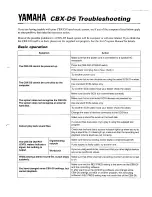
73
Troubleshooting
Theory of Operation GPS Position
GPS Position requires two power line carrier (PLC) boards and a GPS antenna on the end of the machine. In
a typical installation there would be one PLC board in the main control panel powered by 12 VDC and a GPS
tower box on the end of the machine that houses a PLC board, 12 VDC power supply and GPS antenna.
An LED on the PLC displays three different colors that indicate power, transmitting and receiving.
Green = power/idle
Amber = transmitting
Red = receiving
Communication for GPS position originates at the main control panel. Communication data between PLC
boards is typically through the yellow w/red wire (safety out). However, on a 10 wire machine communication is
through the Yellow wire (safety return).
When the control panel is locked in and running, it will make a request to the PLC in the GPS position tower
box on the end of the machine. When the control panel makes the request, the control panel PLC LED should
display amber indicating it is transmitting. At the same time the GPS tower box PLC LED should display red
indicating it is receiving the control panel’s request for position.
The GPS antenna in the tower box outputs a position once every second and when the PLC in the GPS position
tower box receives a request for position, it will transmit the last position in memory back to the control panel.
This is indicated by the GPS position tower box PLC LED displaying an amber color and at the same time the
control panel PLC LED displays red indicating it is receiving the position. The PLC board then passes the posi-
tion onto the module.
When the machine is running, the control panel will request position roughly every 4 seconds and the cycle is
repeated.
• The dipswitch setting of the PLCs also affect communication between the boards. Dipswitches 1-4 are the
PLC I.D. numbers, and 5-8 are the sync pattern. The pattern of 1-4 will change depending upon the location of
the PLC on your machine, however 5-8 will stay the same on the machine. When there are multiple machines
on the same power source, the sync pattern needs to be changed from its factory setting. So that machine
1 has a different sync pattern from machine 2, this will ensure the machines don’t have cross talk between
each other. The recommended setting for dipswitches can be found in the Field Install section of this manual.
• It is recommended that a 15V GPS positioning unit be used on machines that have VFDs or high noise. 15V
GPS units contain a filter, which cleans the data communication when noise is induced on the line before it
enters the PLC.
Summary of Contents for VRI-iS
Page 2: ...2 This page was left blank intentionally...
Page 44: ...This page was left blank intentionally 44 Setup...
Page 50: ...50 Field Install and Wiring Diagrams VRI iS Power Supply Tower Box Field Install pn 9312421...
Page 51: ...51 Field Install and Wiring Diagrams VRI iS Power Supply Tower Box Wiring Schematic pn 0999334...
Page 52: ...52 Field Install and Wiring Diagrams VRI iS GPS Position Tower Box Field Install pn 9312419...
Page 53: ...53 Field Install and Wiring Diagrams VRI iS GPS Position Tower Box Wiring Schematic pn 0999346...
Page 82: ...82 Troubleshooting This page was left blank intentionally...
Page 102: ...102 Parts This page was left blank intentionally...
















































